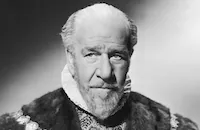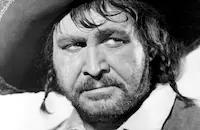Tarzan and the Amazons

Brief Synopsis
Cast & Crew
Kurt Neumann
Johnny Weissmuller
Brenda Joyce
Johnny Sheffield
Henry Stephenson
Mme. Maria Ouspenskaya
Film Details
Technical Specs

Synopsis
While rafting down the river one day, Tarzan and his son Boy hear screams and discover a woman being chased by leopards and a panther. Running from the beasts, the woman plunges off a cliff. After Tarzan repels the beasts, he revives the girl. When Cheetah, their chimpanzee companion, plucks her golden bracelet from the ground, Tarzan explains that she came from Palmyra, a city of women hidden behind the mountains. Because the girl's ankle is sprained, Tarzan carries her home, ordering Boy to stay behind. Boy disobeys, however, and follows Tarzan to the hidden city. Inside the secret kingdom, Tarzan is greeted by his friend, the Amazon Queen, who reminds him all other intruders will be killed. Soon after the incident, Tarzan's mate Jane returns from visiting England with her friend, archaeologist Sir Guy Henderson, who is supervising an expedition with two other Englishmen, Andres and Brenner. Their boat docks at the jungle trading post run by Ballister, and there Cheetah offers Jane the girl's bracelet as a coming home present. Recognizing the emblem of Palmyra that is emblazoned on the bracelet, Brenner questions Tarzan about its origins. Brenner's queries agitate Tarzan, who leaves the post with Jane. After Tarzan's departure, Brenner finds the emblem pictured in a reference book, prompting Ballister to recall stories he has heard about a hidden city of Amazons, filled with treasure. When Ballister suggests that they search for the city, everyone except Sir Guy concurs. They decide to ask Tarzan to guide them to the city, but when Ballister shoots a helpless mother lion, Tarzan refuses to help. Sir Guy then decides to lead the expedition to the north, and they bid farewell to Tarzan, Jane and Boy. Boy, who is fascinated with the scientists' tools, becomes angry at Tarzan for driving away his friends. When Tarzan leaves on a hunting trip alone, Boy follows the expedition and offers to lead them to the secret kingdom. Upon discovering Boy's absence, Jane goes to look for him and encounters a wind storm which knocks over a tree that pins her to the ground. Meanwhile, the expedition crosses the mountains into the city, where it is greeted by the Amazon Queen, who pronounces a sentence of death for all intruders. When the men assure the Queen of their good intentions, however, she relents and spares their lives, sentencing them to hard labor instead. Upon returning home from his hunting trip, Tarzan finds Jane pinned by the tree and rescues her. Back at the hidden city, Boy sends Cheetah to find the girl that Tarzan saved in the jungle and asks her to help them escape. The girl agrees and leads them from their prison, but Ballister, overcome by greed, insists upon plundering the temple before leaving. When Sir Guy objects, Ballister throws him to the ground, killing him. As the girl flees from the pillagers, Ballister plunges a knife into her body, but she manages to sound the alarm before dying. Seeing the carnage, Cheetah runs for Tarzan while the plunderers fend off the women's arrows. Only Andres and Ballister escape through the mountain pass, which they then dynamite to prevent the women from following. The Queen then captures Boy and sentences him to death. Tarzan, summoned by Cheetah, is on his way to Palmyra when he sees Andres and Ballister with their stolen treasure. After chasing them to their death in a pool of quicksand, Tarzan takes the gold. He then uproots a tree to make a bridge across the pass and enters the city, where he returns the treasure and convinces the Queen to spare Boy's life.

Director
Kurt Neumann
Cast

Johnny Weissmuller

Brenda Joyce

Johnny Sheffield

Henry Stephenson
Mme. Maria Ouspenskaya

Barton Maclane

Don Douglas

Steven Geray

J. M. Kerrigan
Shirley O'hara
Crew
James E. Altwies
Scott R. Beal
Robert O. Crandall
John Jacoby
Walter Koessler
Sol Lesser
Norbert Miles
Earl Moser
Kurt Neumann
Phil Paradise
Marjorie L. Pfaelzer
Paul Sawtell
Fleet Southcott
Jean L. Speak
Archie Stout

Videos
Movie Clip



Trailer
Hosted Intro
Film Details
Technical Specs

Articles
Tarzan and the Amazons
By Richard Harland Smith

Tarzan and the Amazons
Quotes
Trivia
Notes
According to a pre-production news item in Hollywood Reporter, Maureen O'Sullivan was initially slated to play "Jane," the role she played in the "Tarzan" films until the 1942 M-G-M film Tarzan's New York Adventure. This marked the first appearance of Brenda Joyce as "Jane", a role that she continued for four more films, ending with the 1949 picture Tarzan's Magic Fountain (see below). A news item in Hollywood Reporter notes that this picture was shot on location at the Baldwin Park Lodge in Los Angeles and Lone Pine, CA. According to a post-production news item in Hollywood Reporter, producer Sol Lesser was so enthusiastic when he saw a rough cut of the film that he decided to increase the budget $100,000 to shoot additional footage. The film was the only Lesser "Tarzan" picture to be made under his Champion Productions banner. For additional information about the series, consult the Series Index, see the entry below for Tarzan Triumphs and see the entry for the 1932 M-G-M film Tarzan, the Ape Man in AFI Catalog of Feature Films, 1931-40.
















